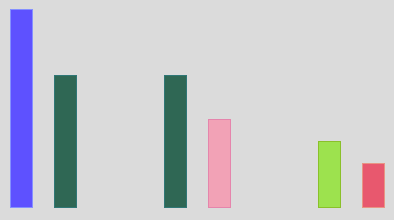Skip over navigation
Here are three pairs of rods:

The ratio of each of these pairs is 3 : 2.
Can you use the interactivity below to show that this is true?
What is the ratio of the pair below? Again, you could use the interactivity to show your thinking.



You can pose the first part of the task by displaying the image on the interactive whiteboard (IWB) and inviting children to use 'real' rods, or the interactivity on a tablet/computer, to demonstrate why the ratio is 3:2. As they work, you may like to take screenshots of some pairs' arrangements, or warn pairs that you will invite them to the front to re-create their arrangement on the IWB in due course.
During a mini plenary, share different ways of showing how we know that the rod pairs are in the ratio 3:2. Some learners might have used white rods to show the equivalent length of each rod in a pair in terms of whites, then simplified; others might have found a rod which is half the length of the smaller rod in the pair and a third of the length of the longer rod.
As learners begin work on the subsequent parts of the problem, when they are asked to find pairs of rods in a particular ratio, you can encourage them to find all the possible pairs, and to explain how they know they have got them all. The thinking for the final part of the problem has already been done in the first part, but it will be interesting to see whether the class realises this at first!
What have you done so far?
What happens if we line up [a particular colour] rods against this pair? How might that help?
(Where applicable) Can you find another pair? And another? Can you find all the pairs in that ratio?


Or search by topic
Number and algebra
Geometry and measure
Probability and statistics
Working mathematically
Advanced mathematics
For younger learners
Rod Ratios
Age 7 to 11
Challenge Level 





- Problem
- Getting Started
- Student Solutions
- Teachers' Resources
Rod Ratios
Here are three pairs of rods:

The ratio of each of these pairs is 3 : 2.
Can you use the interactivity below to show that this is true?
What is the ratio of the pair below? Again, you could use the interactivity to show your thinking.

Here is another pair of rods:

Can you use the interactivity to find other pairs of single rods with the same ratio as the yellow to the pink?
Again, using only pairs of single rods what pairs can you find with the same ratio as those below?

Using only pairs of single rods what pairs can you find with the ratio 9 : 6?
Why do this problem?
Cuisenaire rods are a fantastic resource for investigating ratio. Having the rods as a tool will help children grapple with the quite complex ideas in this task. The rods also provide a visual image which learners might bring to mind at a later date, even when the rods themselves, or the interactivity, are not to hand.Possible approach
If your children are not already familiar with Cuisenaire rods, it is essential to give them time to 'play' with the rods before having a go at this activity. (The way this problem is written assumes some knowledge of the concept of ratio, but Cuisenaire rods could be used to introduce the ideas initially.)You can pose the first part of the task by displaying the image on the interactive whiteboard (IWB) and inviting children to use 'real' rods, or the interactivity on a tablet/computer, to demonstrate why the ratio is 3:2. As they work, you may like to take screenshots of some pairs' arrangements, or warn pairs that you will invite them to the front to re-create their arrangement on the IWB in due course.
During a mini plenary, share different ways of showing how we know that the rod pairs are in the ratio 3:2. Some learners might have used white rods to show the equivalent length of each rod in a pair in terms of whites, then simplified; others might have found a rod which is half the length of the smaller rod in the pair and a third of the length of the longer rod.
As learners begin work on the subsequent parts of the problem, when they are asked to find pairs of rods in a particular ratio, you can encourage them to find all the possible pairs, and to explain how they know they have got them all. The thinking for the final part of the problem has already been done in the first part, but it will be interesting to see whether the class realises this at first!
Key questions
What have you done so far?What happens if we line up [a particular colour] rods against this pair? How might that help?
(Where applicable) Can you find another pair? And another? Can you find all the pairs in that ratio?
Possible support
Having real rods, or access to the interactivity, will help learners 'play' more freely with these ideas without the pressure of committing solutions to paper at first.Possible extension
You could invite learners to find different pairs of rods that are all in the same ratio (a ratio of their choice).You may also like
Teddy Town
There are nine teddies in Teddy Town - three red, three blue and three yellow. There are also nine houses, three of each colour. Can you put them on the map of Teddy Town according to the rules?
Four Triangles Puzzle
Cut four triangles from a square as shown in the picture. How many different shapes can you make by fitting the four triangles back together?

